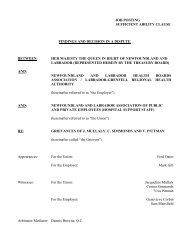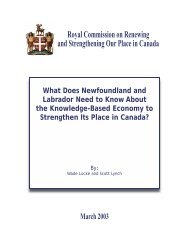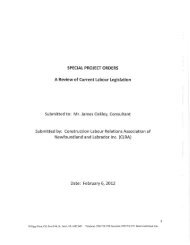Energy Plan - Government of Newfoundland and Labrador
Energy Plan - Government of Newfoundland and Labrador
Energy Plan - Government of Newfoundland and Labrador
Create successful ePaper yourself
Turn your PDF publications into a flip-book with our unique Google optimized e-Paper software.
POLICY<br />
ACTIONS<br />
Capturing the Value <strong>of</strong> Our<br />
Renewable <strong>Energy</strong><br />
The <strong>Government</strong> <strong>of</strong><br />
<strong>Newfoundl<strong>and</strong></strong> <strong>and</strong> <strong>Labrador</strong> will:<br />
• Support <strong>and</strong> advance<br />
initiatives to regulate <strong>and</strong><br />
limit GHG emissions in<br />
a manner that promotes<br />
renewable energy<br />
development<br />
• Ensure that the province<br />
captures the incremental<br />
value <strong>of</strong> our renewable energy<br />
as a result <strong>of</strong> emissions<br />
regulation.<br />
Intensity based <strong>and</strong> Fixed Emissions Caps<br />
In the long term, the province must set caps on the amount <strong>of</strong> emissions<br />
allowed from various GHG emitting entities. Such caps will potentially have<br />
both a positive environmental impact <strong>and</strong> a negative economic impact in some<br />
sectors. The implementation <strong>of</strong> any such emissions caps must be approached<br />
in a balanced manner, allowing the appropriate amount <strong>of</strong> time to properly<br />
facilitate a prudent economic transition while ensuring the proper long–term<br />
stewardship <strong>of</strong> our environment.<br />
As we develop the Lower Churchill <strong>and</strong> other clean renewable energy projects,<br />
the <strong>Government</strong> <strong>of</strong> <strong>Newfoundl<strong>and</strong></strong> <strong>and</strong> <strong>Labrador</strong> <strong>and</strong> the <strong>Energy</strong> Corporation<br />
will pay close attention to the development <strong>of</strong> GHG emission regulations <strong>and</strong><br />
trading in Canada <strong>and</strong> the United States. Furthermore, the <strong>Energy</strong> Corporation<br />
will advocate its interests to ensure that it is positioned to capture the increase<br />
in value that is attributable to the regulation <strong>of</strong> GHG emissions in the electricity<br />
sector.<br />
L<strong>and</strong>, Water <strong>and</strong> Wildlife<br />
GHGs are a critical environmental challenge facing the global energy sector <strong>and</strong><br />
we must play our part in dealing with this challenge. It is also essential that we<br />
preserve <strong>and</strong> protect our l<strong>and</strong>, water <strong>and</strong> wildlife to the greatest extent possible<br />
as our energy sector is developed. These resources are this province’s natural<br />
legacy for future generations.<br />
Development <strong>of</strong> our energy resources creates the potential for environmental<br />
impact <strong>and</strong> has to be carefully managed. For example, oil <strong>and</strong> gas exploration<br />
<strong>and</strong> production carry a risk <strong>of</strong> oil spills <strong>and</strong> introduce issues associated with<br />
site restoration; hydroelectric project reservoirs flood l<strong>and</strong> <strong>and</strong> can disrupt river<br />
flows <strong>and</strong> fish habitats; wind farms are spread across considerable areas (even<br />
though the l<strong>and</strong> in between the wind turbines can be used for some activities);<br />
<strong>and</strong>, electricity transmission lines <strong>and</strong> gas pipelines can interfere with wildlife<br />
migrations. The new Sustainable Development Act will ensure renewable <strong>and</strong><br />
non-renewable resources are developed to maximize benefits for the province,<br />
while protecting the natural environment so that future generations have the<br />
ability to meet their own needs.<br />
56<br />
In addition, energy exploration <strong>and</strong> development projects are subject to rigorous<br />
environmental impact assessments under the provincial Environmental Assessment<br />
Act <strong>and</strong>/or the Canadian Environmental Assessment Act. Such assessments<br />
thoroughly examine the impacts energy activities might have on the environment<br />
<strong>and</strong> ensure they are mitigated. These processes also provide for significant<br />
opportunity for public input on the impact <strong>of</strong> these developments. The processes<br />
are effective, but can take considerable time. The Provincial <strong>Government</strong> is working<br />
with other jurisdictions through the Council <strong>of</strong> the Federation, the Council <strong>of</strong> <strong>Energy</strong><br />
Ministers <strong>and</strong> the Canadian Council <strong>of</strong> Ministers <strong>of</strong> the Environment to improve the<br />
timeliness <strong>and</strong> certainty <strong>of</strong> regulatory approval decision-making processes while<br />
maintaining rigorous protection <strong>of</strong> the environment <strong>and</strong> public interest.

















